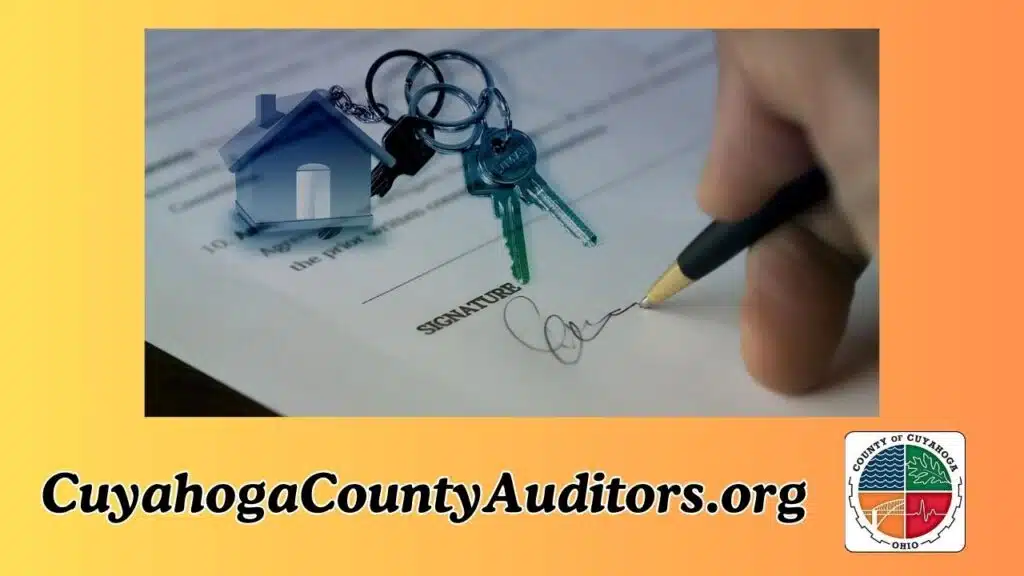The Cuyahoga County Auditor is key in making sure property assessments are fair and accurate. They use different strategies to value properties based on the current market. This ensures fairness for all property owners.
We will explore how the Cuyahoga County Auditor’s office makes sure property assessments are fair. We will also see why being transparent in this process is important for homeowners and businesses.
What is Cuyahoga County’s Property Assessment?
In Cuyahoga County, property assessments are the value of real estate for tax purposes. They decide how much property owners pay in taxes.
The Cuyahoga County Auditor’s office makes sure these assessments are accurate and current. They consider many factors like market trends and property conditions.
Property assessments are important because they affect how much homeowners and businesses pay in property taxes. These taxes fund local services like schools and roads.

Why is Fairness Important in Property Assessments?
It’s important to have fair property assessments to keep trust in local government and taxes. If assessments are not fair, some people might pay too much, while others might pay too little. This can cause confusion and resentment in the community.
A fair system means everyone pays based on their property’s true value. This promotes fairness and helps keep local services funded by property taxes.
Cuyahoga County Auditor’s Strategies for Fair Property Assessments
The Cuyahoga County Auditor uses several strategies for fair and transparent assessments. These include using the latest market data, checking property conditions regularly, and involving the public. Let’s look at these strategies in more detail.
1. Using Market Data for Accurate Assessments
The Cuyahoga County Auditor’s office bases assessments on market data. This includes recent sales, local trends, and real estate conditions. This way, assessments reflect the true market value of properties.
For example, if sales in a neighborhood go up, assessments might increase. If sales go down, assessments might decrease to keep things fair.
Key Market Factors Considered in Property Assessments:
- Recent Property Sales: Sales of similar properties help set a value baseline.
- Neighborhood Trends: The area’s condition and popularity affect assessments.
- Economic Factors: Local economy, job growth, and development impact values.
- Property Improvements: Big changes to a property can raise its assessment.
2. Regular Property Reviews and Inspections
The Cuyahoga County Auditor regularly checks properties to keep assessments accurate. Properties are not just assessed once; they are reviewed often. Changes in property conditions are taken into account.
For instance, adding a new room or making big upgrades can lead to a reassessment. If a property gets damaged, its assessment might change too.
Benefits of Regular Property Reviews:
- Up-to-Date Assessments: Values stay current with the market.
- Accurate Reflections of Property Conditions: Improvements and damages are considered.
- Transparency: Owners are informed about changes to their property values.
3. Transparency and Public Involvement
The Cuyahoga County Auditor’s office values transparency. They want property owners to know how their taxes are calculated. They also want owners to be able to review and challenge their assessments if needed.
The office makes property assessment data public. They also let owners contest their assessments if they think the value is wrong. This includes formal appeals where owners can show why their property’s value should change.
Ways the Auditor Ensures Transparency:
- Online Access: Owners can easily see their property assessments and data online.
- Public Meetings and Hearings: Regular meetings let the public ask questions and give feedback.
- Clear Appeal Process: A clear process lets owners appeal their assessments if they think they’re wrong.
4. Use of Advanced Technology
The Cuyahoga County Auditor uses advanced technology for better property assessments. They use Geographic Information Systems (GIS) and other digital tools. These tools help analyze property data, map neighborhoods, and predict property values.
These technologies help the Auditor’s office make faster, more accurate decisions. This ensures property assessments are both accurate and efficient.
Technological Tools Used in Assessments:
- Geographic Information Systems (GIS): Helps map properties and assess value changes in specific locations.
- Automated Valuation Models (AVMs): Use algorithms to predict property values based on data.
- Online Property Assessment Tools: Provide easy access for property owners to review and understand their assessments.
5. Equity in Assessments Across Different Property Types
Ensuring fairness in property assessments is key. The Auditor’s office treats all property types equally and fairly. They use special strategies for different types of properties to ensure fairness.
For example, assessing commercial properties might need different criteria than residential ones. But fairness, accuracy, and market data apply to all types.
6. Education and Outreach Programs
The Cuyahoga County Auditor’s office educates the public about property assessments. They offer workshops, informational sessions, and online resources. These help property owners understand how their taxes are calculated and what to do if they disagree with their assessment.
These programs build trust between the Auditor’s office and the community. They make sure property owners feel informed and empowered.
Benefits of Transparency and Fairness in Property Assessments
- Builds Trust: When property owners understand the assessment process and believe it’s fair, they trust local government more.
- Ensures Fair Taxation: Accurate assessments mean everyone pays their fair share, based on their property’s value.
- Encourages Public Engagement: Transparency encourages property owners to participate in the assessment process. This leads to better decisions and more accurate assessments.
Key Property Assessment Factors
| Factor | Description |
|---|---|
| Market Data | Recent property sales and neighborhood trends. |
| Property Improvements | Changes such as renovations or damage to property. |
| Economic Conditions | Impact of local economy and real estate market trends. |
| Technology and GIS | Use of tools to map properties and predict values. |
| Appeal Process | Mechanisms for property owners to contest assessments. |
Common Property Assessment Challenges
| Challenge | Solution |
|---|---|
| Market Fluctuations | Use of recent data and trends to adjust property values. |
| Property Condition Discrepancies | Regular inspections to reflect true property conditions. |
| Confusion Around Tax Rates | Clear communication of assessment criteria and appeal options. |
| Inconsistent Assessments | Standardized methodologies for all property types. |
Conclusion
The Cuyahoga County Auditor’s office is key in making sure property assessments are fair and clear. They use the latest market data and technology. They also work to involve the public in the process.
This helps make sure property owners pay taxes based on their property’s real value. The office regularly checks assessments, talks clearly with the public, and makes it easy to appeal. This builds trust and helps make taxes fairer for everyone in Cuyahoga County.
As a property owner, knowing about the assessment process is important. Getting involved in public programs can help you understand your taxes better. This way, Cuyahoga County keeps its property assessment fair and open for all.






